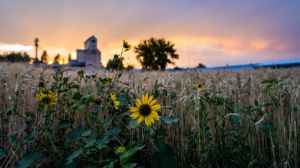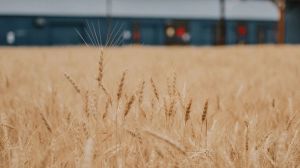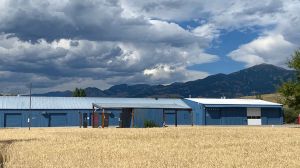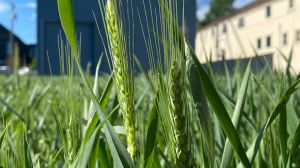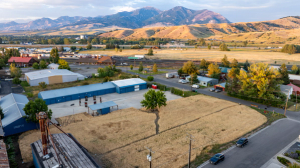
Agnes Denes Wheatfield—An Inspiration. The seed is in the ground, 2024. Tinworks Art. Courtesy the artist and Leslie Tonkonow Artworks + Projects. Photo by Matthew MaCoy.
Overview
As part of its 2024 exhibition, The Lay of The Land, Tinworks presented a significant new work by artist Agnes Denes, Wheatfield - An Inspiration. The seed is in the ground. Denes will continue her activation of Tinworks’ field for our 2025 season with another new ecological artwork, Sunflowers—to follow the wheat. An array of pink sunflowers chosen by Denes will help rejuvenate and restore the land at Tinworks, demonstrating nature’s resilience while bringing a sense of surprise and beauty to the community.
Denes engages science, philosophy, math, linguistics, technology, engineering, urban planning, music, and poetry in visionary artworks that explore environmental issues and humanity’s impact on the planet. One of her most celebrated works, Wheatfield - A Confrontation, was planted in New York City in 1982. It consisted of a two-acre field planted in the landfill created from the construction of the World Trade Center. Her 2024 Wheatfield for Tinworks is the first time Denes accepted an invitation to reposition the work in another American context. Reimagining Wheatfield in Bozeman was particularly compelling to Denes because of the significant role of wheat in the history and economy of Montana, the increasing loss of farmland to urban development in the Gallatin Valley, and the opportunity to devote the field at Tinworks to public art installations.
An important component of the new wheatfield work was an invitation to the community to plant wheat in solidarity in any fallow piece of land, to experiment if a community could come together in a creative act to produce a sustainable crop of wheat. Over a dozen community partners participated, and on September 9, 2024, Denes’ wheatfield was harvested by 200 volunteers. Her wheat circulated through the community as bread baked by Bozeman bakery Wild Crumb and in pounds of milled flour distributed by the Gallatin Valley Food Bank. It will continue to provide sustenance as bread that will be baked in Gabriel Chaile’s oven sculpture throughout Tinworks’ 2025 exhibition season.
As Denes explains, “The Wheatfield is hope. There is renewal in the seed. We are planting hope.”
How You Can Take Part
We invite you to become a part of the art by completing Questionnaire, an artwork first begun in 1979 in which Denes poses questions about the most pressing issues facing humanity, inviting answers and solutions from the community.
Wheatfield - A Confrontation: Battery Park Landfill, Downtown Manhattan
About the Artist
A pioneering figure in conceptual and environmental art, Agnes Denes’ practice confronts urgent questions around land use, sustainability, and humans’ impact on the planet through poetic, monumental works grounded in deep research. Since 1968, she has created site-specific projects that often also act as environmental remediations. Denes is perhaps best known for Wheatfield—A Confrontation (1982). Her Tree Mountain (1992-1996) consists of 11,00 fir trees, planted by 11,000 people in Finland, who received certificates giving them stewardship of the tree they planted for 400 years. The Living Pyramid was originally commissioned by Socrates Sculpture Park in 2015. It is a 30 foot x 30 foot x 30 foot structure in which plants are planted that are indigenous to the location in which it is presented. It has been featured in documenta 14 (2017), the Sakip Sabanci Museum, Istanbul (2022), the Hayward Gallery, London (2023) and Desert X, Palm Spring (2025). Denes’ work is in major museum collections around the world. Recent solo exhibitions have been presented at The Museum of Fine Arts Budapest (2024), Lunds konsthalle, Sweden (2024), The Shed, New York (2019). Born in Budapest in 1931, she lives and works in New York City.

